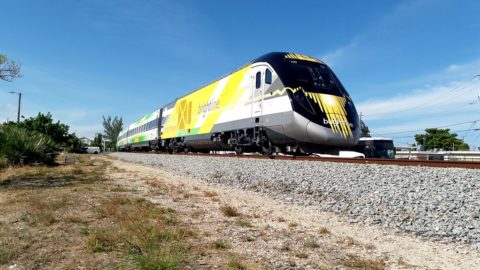The Korean War by Indy Neidell
Published 8 Oct 2024This week the KPA continue to grapple with the hole made by the landings at Incheon, as South Korean forces push past the 38th Parallel. MacArthur’s attention, however, is already on his next big gambit: a landing at Wonsan. South Korean forces may very well beat him to the punch, though, as their drive north continues. Beyond the Yalu River, Mao Zedong watches these developments closely, and plans his response.
Chapters
00:51 Recap
01:12 Seoul Aftermath
03:50 ROK Enters North Korea
05:28 The UN Resolution
07:36 Crossing the Parallel
14:25 The Wonsan Plan
16:38 Conclusion
(more…)
October 9, 2024
The Korean War 016 – South Koreans Invade the North! – October 8, 1950
Dangling the old “high speed rail between Toronto and Montreal” proposal again
In what seems like an annual ritual, the attractive-to-many (but economically non-viable) idea of putting in a high speed rail line between Toronto and Montreal is getting another airing:

The closest active model to the proposed VIA “High Frequency Rail” proposal is the Brightline service in Florida.
“BrightLine – The Return of FEC passenger service” by BBT609 is licensed under CC BY 2.0
In 2021, the Government of Canada confirmed its plans to significantly upgrade VIA Rail’s passenger rail service between the Windsor and Quebec City corridor into a high-frequency rail service.
As the name suggests, this new high-frequency rail service would offer significantly higher frequencies and reduce travel times on the route linking Toronto, Ottawa, and Montreal by 25 per cent.
With dedicated passenger rail tracks separate from freight operations, which greatly contribute to current service delays, this new train service would more consistently operate at increased speeds of up to 177 km/h to 200 km/h, and reliability would improve to an on-time performance by over 95 per cent.
This is quite true … the existing rail network between Toronto, Montreal and Ottawa was designed and built to carry freight traffic first and passengers only as a secondary goal — in many cases to attract government subsidies for the construction of the lines. Passenger services are, at best, marginally profitable but generally passenger service is a dead loss for the railways and only maintained thanks to ongoing government subsidies, grants, and tax breaks.
Freight trains — the profitable part of the railway network — have gotten longer and heavier over time as technology has improved (and train crews have gotten smaller, reducing labour costs) and the signal systems are optimized for freight traffic: long, slow-moving trains that take a lot of time and energy to speed up and slow down. Passenger trains travel faster (well, theoretically anyway) and make frequent stops to pick up and drop off passengers … signalling systems (which are critical to safe operations) need to be designed to optimize the usage pattern of the majority of the trains which in practice means freight with some modifications in high-population areas to accommodate passenger traffic.
This high-frequency rail service would use VIA Rail’s new and growing fleet of modern Siemens Venture trains operating on the Windsor-Quebec City corridor.
But as it turns out, the federal government is also contemplating a new service that is even better than high-frequency rail — the potential for a high-speed rail service, which would be the first of its kind in Canada.
Currently, the federal government is engaged in the Request For Proposal (RFP) process for the project. In July 2023, it shortlisted three private consortiums to participate in the RFP’s detailed bidding process, attracting international interest from major investors and some of the world’s largest passenger rail service operators.
This includes the consortium named Cadence, entailing CDPQ Infrastructure, AtkinsRealis (formerly known as SNC-Lavalin), Systra Canada, Keolis Canada, SNCF Voyageurs, and national flag carrier Air Canada.
The inclusion of Air Canada in the consortium is … interesting … as one of the goals of an actual high speed system would be to drain off a proportion of the short-haul passenger traffic that currently goes by air. A cynic might wonder if Air Canada’s interest in the project is to help or hinder.
According to a report in Toronto Star last week, each of the three consortiums was directed to create two detailed proposals, including one concept with trains that travel under 200 km/h and another concept with trains that travel faster than 200 km/h.
High-speed rail is generally defined as a train service that operates at speeds of at least 200 km/h.
It was further stated in the report that the new service could result in travel times of only three hours between Toronto and Montreal, as opposed to the current travel times of over five hours on existing VIA Rail services.
For further comparison, the travel time between Toronto and Montreal on flight services such as Air Canada is about 1.5 hours, which does not include the time spent at airports, while the driving time over this distance of over 1,000 km is about 5.5 hours — similar to VIA Rail’s existing services.
The potential holds for VIA Rail’s new service to operate at speeds over 200 km/h along select segments of the corridor.
The required costs to implement 200km/h speeds will be in eliminating as many grade crossings as possible and reconstructing some tight curves to allow the higher speed trains … and, as mentioned earlier, retrofitting the signal system for the faster passenger trains. Even those measures, which don’t really produce a true “high speed” system will be very expensive.
How to Make a Simple Picture Frame | Episode 1
Paul Sellers
Published Jun 7, 2024This is a uniquely different way to make a picture frame, but Paul designed it specifically to work with hand tools.
Sizing the eight components with the level of precision needed can be tricky, but two guides make the whole process quick and simple. We have dispensed with the mitres normally associated with picture frames altogether, giving these frames an assembly process and look you’ve never seen before.
It’s a step-by-step process with accuracy and we walk you through every step.
(more…)
QotD: The hijacking of the Canadian identity
The anniversary of that first May 27, 2021 unmarked-graves announcement came and went a few weeks ago, with barely a peep from prominent figures in the Canadian progressive firmament. And the same Trudeau who’d recently served up lurid sermons about our status as a blood-stained genocide state has now switched into proto-campaign mode, gushing manically about the Liberal horn of plenty set to deluge this nation with riches. According to the latest Liberal agitprop, in fact, patriotic Trudeauvian boosterism isn’t merely permissible — why, it’s obligatory. So light up those Canada Day backyard barbecues. Canuck Yom Kippur is finally over.
But before we dismiss this three-year interregnum as a dystopian fever dream, it’s worth asking how our collective Canadian identity could be hijacked — even temporarily — in such a radicalized manner. And the truth is that it isn’t just progressive ideologues who bear responsibility; but also their counterparts on all parts of the political spectrum, few of whom exhibited any inclination to offer pushback while these falsehoods took root in the media. Even many writers at this newspaper, generally held to be a right-leaning outlet, greeted the unmarked-graves claims by heaping shame on their country.
In every other comparably advanced society, there exists a natural tension between conservative nationalists who reverentially sentimentalize their history, and the progressive critics who reflexively denounce it. And it is from out of that tension that something approaching the historical truth emerges. Or, at least something close enough to the historical truth that it provides a stable and coherent basis upon which a society can confidently pin its collectively embraced national identity.
What we learned in 2021 is that this necessary tension doesn’t exist in Canada, because traditionalists can no longer describe their nation’s history in a way that gives voice to their emotionally felt patriotism without attracting claims of racism and neocolonialism. As a result, our marketplace of ideas lacks the checks and balances required to inure us against — oh, gee, I don’t know, let’s take a crazy example — apocalyptic medieval fables in which legions of Indigenous children are thrown into furnaces and shallow graves by cackling nuns and diabolical priests.
So yes, shame on Trudeau for lowering the Canadian flag on federal buildings for half a year to honour victims entombed in non-existent mass graves. But shame on the rest of us for staring at our shoes while this blood libel was being signal-boosted. And now that Trudeau seems on his way out — and, with him, the maudlin, tear-soaked, bent-knee political shtick that accompanied this descent into hysteria — we might turn our attention toward developing a national self-identity sufficiently robust that it doesn’t fall to pieces the next time someone claims to have found genocide’s residue under an old tetherball court.
Jonathan Kay, “Don’t let politicians misinform you. Learn about Canada’s true history for yourself”, National Post, 2024-07-01.




